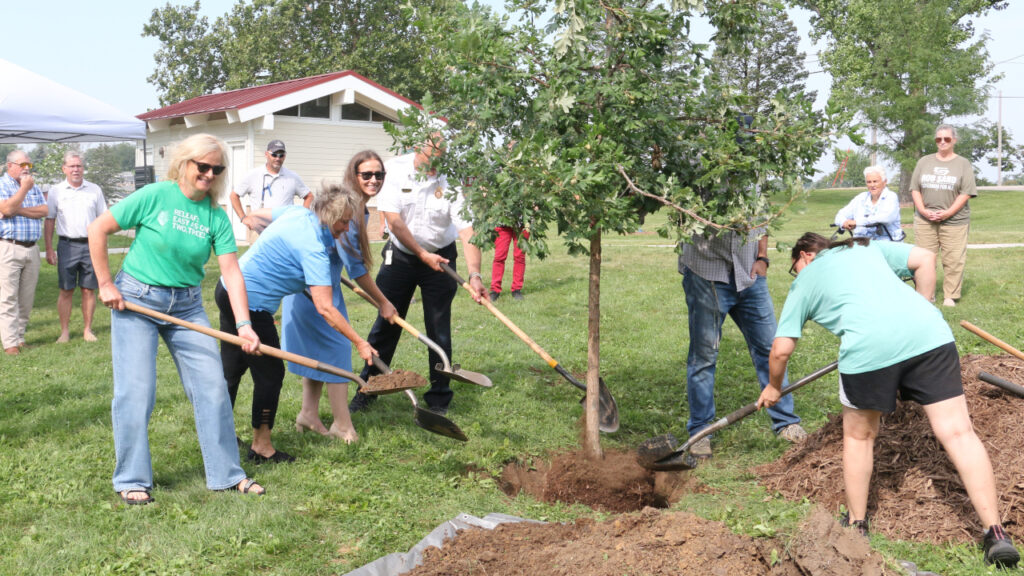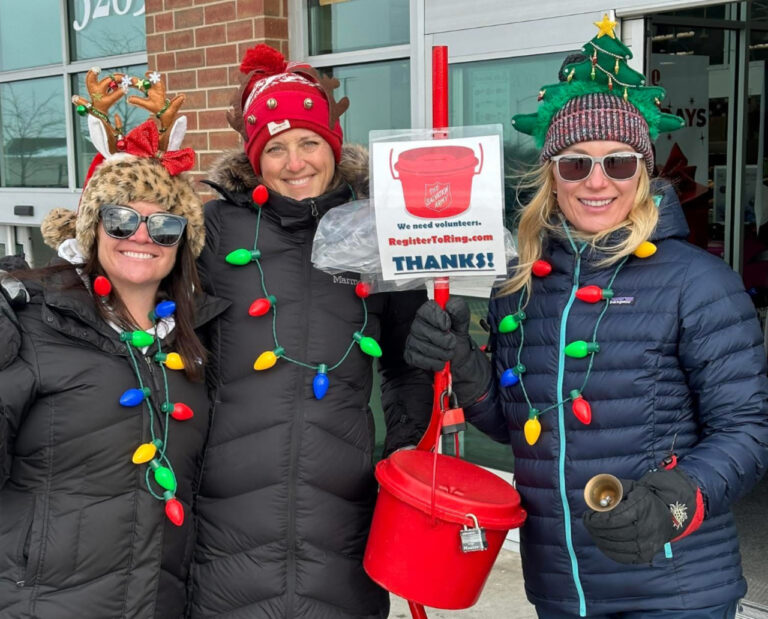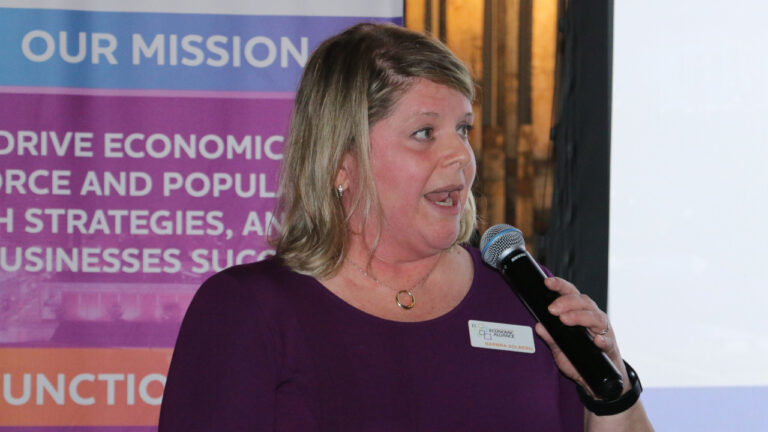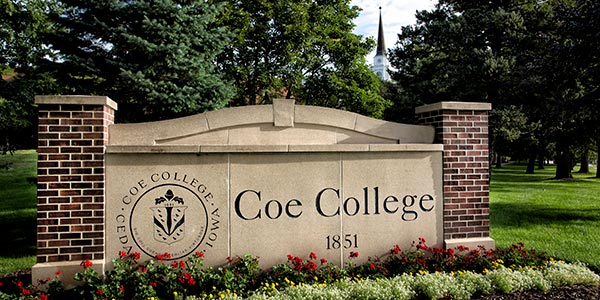The August 2020 derecho inflicted billions of dollars in damage across the Midwest, including a massive economic impact in Cedar Rapids – but local leaders, at a derecho commemoration ceremony Friday, focused on the extensive devastation to the city’s tree canopy and how the city has addressed that issue in the past five years.
Originating in eastern Nebraska and moving through Iowa and Illinois, the derecho formed suddenly on Monday, Aug. 10, 2020, producing hurricane-force winds that reached up to 140 mph for up to 40 minutes in some areas, causing widespread power outages, damage to homes and businesses, and crop destruction.
The numbers alone are staggering. The 2020 derecho is considered to be the costliest thunderstorm event in U.S. history, leaving an estimated $11 billion in damage in its wake. More than 1 million and businesses were left without power, some for as long as two weeks.
In Iowa, Alliant Energy workers replaced more than 3,600 power poles and restrung 6 million feet of power lines, aided by utility crews from across Iowa and the United States. State officials estimated Iowa utilities sustained $100 million in damage from the storm.
In Cedar Rapids alone, virtually every structure in the city’s 75 square miles was impacted in some way. Cedar Rapids businesses sustained approximately $133 million in damage, with about half not covered by insurance. More than 1,000 homes were declared uninhabitable in the storm’s wake.
And an estimated 670,000 trees were lost – 65% of the city’s tree canopy. That’s the aspect of the storm’s ferocity that is still being addressed today, speakers at Friday’s event emphasized.
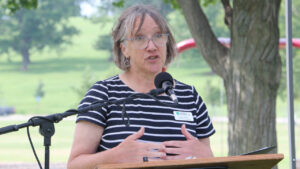
“I understood that what we lost was not just a natural resource,” said Carole Teator, program manager for ReLeaf Cedar Rapids, at Friday’s ceremony at Jones Park in southwest Cedar Rapids. “We lost what shaped our daily lives.”
ReLeaf Cedar Rapids is a public-private partnership funded jointly by the City of Cedar Rapids – which has pledged $1 million to the effort annually for 10 years – government grants, private fundraising, and the nonprofit organization Trees Forever.
“The ReLeaf Cedar Rapids plan gives us the tools and structure to restore what was lost,” Ms. Teator said Friday. “It is built on public input, rooted in science and designed to ensure that every neighborhood has access to the benefits a healthy urban forest can provide. ReLeaf is not just about planting. It’s about planting with purpose.”
Cedar Rapids mayor pro tem Ann Poe said the aftermath of the storm was jarring.
“When the storm passed and the people came out, they saw beloved trees laying across lawns and streets, homes that were devastated and neighborhoods that were unrecognizable,” she said. “In the midst of an already difficult year because of the COVID-19 pandemic, the grief was real and it was shared across the entire community. But what followed was just as powerful. Neighbors came together. People checked in on one another, cleared streets, shared resources and found strength in each other. Cedar Rapidians did what they know how to do, the thing we do best when times are tough – we work together, we help neighbors, and we began to recover.”
Cedar Rapids city administrator Jeff Pomeranz also acknowledged the community’s post-derecho resilience.
“As city manager, I view recovery not as a cleanup, but as a long-term implementation where we’re working to make our community better and stronger,” he said. “Our responsibility is to take action, to lead with purpose and to build systems that guide sustainable results.”
He noted that Cedar Rapids has already replanted more than 16,000 trees on city-owned properties, “and residents, nonprofits, businesses have planted thousands more.”
He said a cleanup company hired by the city, which had worked with natural disasters across the United States and worldwide, “called this disaster the worst they had ever seen.”
He also highlighted the city’s Neighborhood P.A.C.T. (Prepare, Act, Communicate, Train) program, established in response to the derecho.
The program aims to enhance community preparedness for future emergencies and disasters, and includes the framework for Neighborhood Resource Centers, which would be open to the community in future disasters, serving as distribution centers for information and resources.
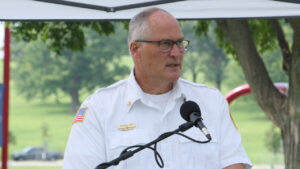
Cedar Rapids fire chief Greg Smith, who serves as the city’s incident commander during large-scale emergencies such as the 2020 derecho, outlined the incident management team and how its role has been redefined since the storm.
“The incident management team brings together city departments under one process that allows us to prioritize the needs against available resources and helps us determine when and whom to call for help,” Mr. Smith said. “Since the derecho the incident management team has honed our skills with drills and exercises (and) expanded our relationships with regional and state partners. At the local level, we have (established) a resiliency program designed to help home and business owners prepare for the unexpected. Prepare, act, communicate, train. It’s our digital and physical outreach effort that offers ideas, training and plans for the common citizen to prepare for the first 24 to 72 hours after a disaster. This is a critical time for community resilience. It gives us time as a city to start providing longer term support to those in need.
“In the five years since the derecho, we’ve implemented innovative solutions to our needs and found a way to bring them to our residents,” he added. “We are strong, ready for what’s next and seeking continuous improvement in all facets of preparation and response.”
Friday’s event ended with the ceremonial planting of a burr oak tree, considered one of the preferred Iowa-native species for post-derecho replanting.
“What we dedicate today is not just a tree,” Ms. Teator said. “It is a step in the right direction, and like every other tree planted under this plan, it represents more than the sum of its branches. It represents progress, patience and a shared belief that Cedar Rapids is worth investing in, leaf by leaf, block by block, season after season.”


